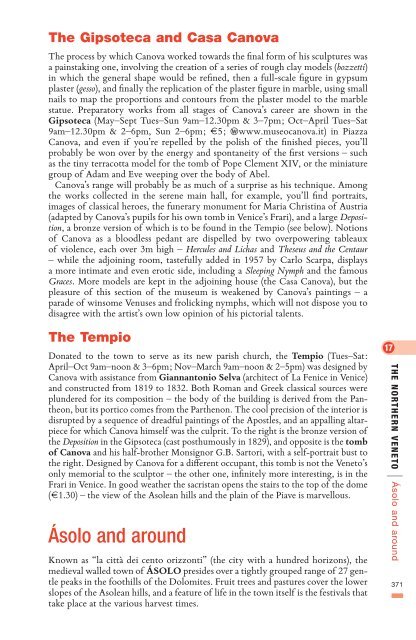Create successful ePaper yourself
Turn your PDF publications into a flip-book with our unique Google optimized e-Paper software.
<strong>The</strong> Gipsoteca <strong>and</strong> Casa Canova<br />
<strong>The</strong> process by which Canova worked <strong>to</strong>wards <strong>the</strong> final form of his sculptures was<br />
a painstaking one, involving <strong>the</strong> creation of a series of rough clay models (bozzetti)<br />
in which <strong>the</strong> general shape would be refined, <strong>the</strong>n a full-scale figure in gypsum<br />
plaster (gesso), <strong>and</strong> finally <strong>the</strong> replication of <strong>the</strong> plaster figure in marble, using small<br />
nails <strong>to</strong> map <strong>the</strong> proportions <strong>and</strong> con<strong>to</strong>urs from <strong>the</strong> plaster model <strong>to</strong> <strong>the</strong> marble<br />
statue. Prepara<strong>to</strong>ry works from all stages of Canova’s career are shown in <strong>the</strong><br />
Gipsoteca (May–Sept Tues–Sun 9am–12.30pm & 3–7pm; Oct–April Tues–Sat<br />
9am–12.30pm & 2–6pm, Sun 2–6pm; e5; wwww.museocanova.it) in Piazza<br />
Canova, <strong>and</strong> even if you’re repelled by <strong>the</strong> polish of <strong>the</strong> finished pieces, you’ll<br />
probably be won over by <strong>the</strong> energy <strong>and</strong> spontaneity of <strong>the</strong> first versions – such<br />
as <strong>the</strong> tiny terracotta model for <strong>the</strong> <strong>to</strong>mb of Pope Clement XIV, or <strong>the</strong> miniature<br />
group of Adam <strong>and</strong> Eve weeping over <strong>the</strong> body of Abel.<br />
Canova’s range will probably be as much of a surprise as his technique. Among<br />
<strong>the</strong> works collected in <strong>the</strong> serene main hall, for example, you’ll find portraits,<br />
images of classical heroes, <strong>the</strong> funerary monument for Maria Christina of Austria<br />
(adapted by Canova’s pupils for his own <strong>to</strong>mb in <strong>Venice</strong>’s Frari), <strong>and</strong> a large Deposition,<br />
a bronze version of which is <strong>to</strong> be found in <strong>the</strong> Tempio (see below). Notions<br />
of Canova as a bloodless pedant are dispelled by two overpowering tableaux<br />
of violence, each over 3m high – Hercules <strong>and</strong> Lichas <strong>and</strong> <strong>The</strong>seus <strong>and</strong> <strong>the</strong> Centaur<br />
– while <strong>the</strong> adjoining room, tastefully added in 1957 by Carlo Scarpa, displays<br />
a more intimate <strong>and</strong> even erotic side, including a Sleeping Nymph <strong>and</strong> <strong>the</strong> famous<br />
Graces. More models are kept in <strong>the</strong> adjoining house (<strong>the</strong> Casa Canova), but <strong>the</strong><br />
pleasure of this section of <strong>the</strong> museum is weakened by Canova’s paintings – a<br />
parade of winsome Venuses <strong>and</strong> frolicking nymphs, which will not dispose you <strong>to</strong><br />
disagree with <strong>the</strong> artist’s own low opinion of his pic<strong>to</strong>rial talents.<br />
<strong>The</strong> Tempio<br />
Donated <strong>to</strong> <strong>the</strong> <strong>to</strong>wn <strong>to</strong> serve as its new parish church, <strong>the</strong> Tempio (Tues–Sat:<br />
April–Oct 9am–noon & 3–6pm; Nov–March 9am–noon & 2–5pm) was designed by<br />
Canova with assistance from Giannan<strong>to</strong>nio Selva (architect of La Fenice in <strong>Venice</strong>)<br />
<strong>and</strong> constructed from 1819 <strong>to</strong> 1832. Both Roman <strong>and</strong> Greek classical sources were<br />
plundered for its composition – <strong>the</strong> body of <strong>the</strong> building is derived from <strong>the</strong> Pan<strong>the</strong>on,<br />
but its portico comes from <strong>the</strong> Par<strong>the</strong>non. <strong>The</strong> cool precision of <strong>the</strong> interior is<br />
disrupted by a sequence of dreadful paintings of <strong>the</strong> Apostles, <strong>and</strong> an appalling altarpiece<br />
for which Canova himself was <strong>the</strong> culprit. To <strong>the</strong> right is <strong>the</strong> bronze version of<br />
<strong>the</strong> Deposition in <strong>the</strong> Gipsoteca (cast posthumously in 1829), <strong>and</strong> opposite is <strong>the</strong> <strong>to</strong>mb<br />
of Canova <strong>and</strong> his half-bro<strong>the</strong>r Monsignor G.B. Sar<strong>to</strong>ri, with a self-portrait bust <strong>to</strong><br />
<strong>the</strong> right. Designed by Canova for a different occupant, this <strong>to</strong>mb is not <strong>the</strong> Vene<strong>to</strong>’s<br />
only memorial <strong>to</strong> <strong>the</strong> sculp<strong>to</strong>r – <strong>the</strong> o<strong>the</strong>r one, infinitely more interesting, is in <strong>the</strong><br />
Frari in <strong>Venice</strong>. In good wea<strong>the</strong>r <strong>the</strong> sacristan opens <strong>the</strong> stairs <strong>to</strong> <strong>the</strong> <strong>to</strong>p of <strong>the</strong> dome<br />
(e1.30) – <strong>the</strong> view of <strong>the</strong> Asolean hills <strong>and</strong> <strong>the</strong> plain of <strong>the</strong> Piave is marvellous.<br />
Ásolo <strong>and</strong> around<br />
Known as “la città dei cen<strong>to</strong> orizzonti” (<strong>the</strong> city with a hundred horizons), <strong>the</strong><br />
medieval walled <strong>to</strong>wn of ÁSOLO presides over a tightly grouped range of 27 gentle<br />
peaks in <strong>the</strong> foothills of <strong>the</strong> Dolomites. Fruit trees <strong>and</strong> pastures cover <strong>the</strong> lower<br />
slopes of <strong>the</strong> Asolean hills, <strong>and</strong> a feature of life in <strong>the</strong> <strong>to</strong>wn itself is <strong>the</strong> festivals that<br />
take place at <strong>the</strong> various harvest times.<br />
<strong>the</strong> nor<strong>the</strong>rn vene<strong>to</strong> Ásolo <strong>and</strong> around<br />
|<br />
371







